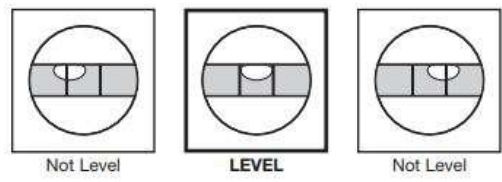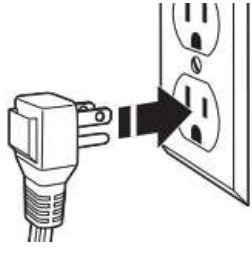Whirlpool W11354658B Top Load Washer
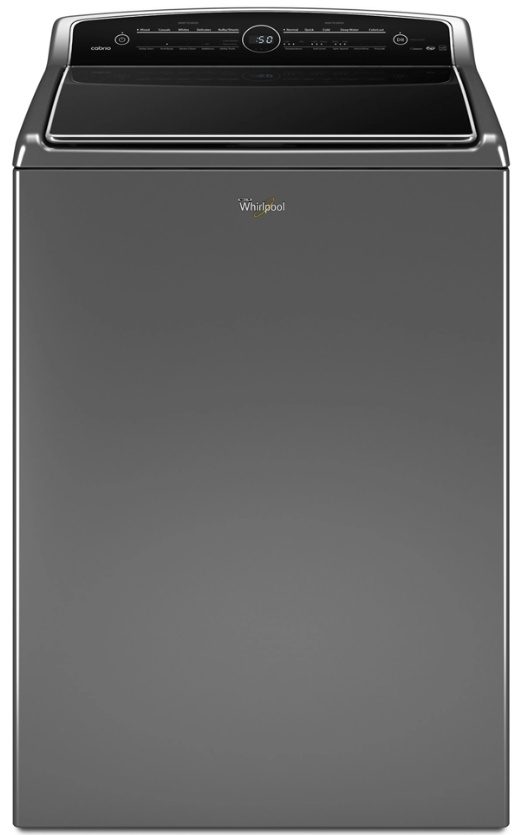
Safety Instructions
- Read all instructions before using the appliance.
- These substances give off vapors that could ignite or explode.
- Do not allow children to play on or in the appliance.
- Do not reach into the appliance if the tub or agitator is moving.
- Do not tamper with controls.
- Do not repair or replace any part of the appliance or attempt any servicing unless specifically recommended in the user-maintenance instructions or in published user-repair instructions that you understand and have the skills to carry out.
- See the Installation Instructions for grounding requirements and installation.
Electrical Requirements
- A 120 V, 60 Hz, AC-only, 15 or 20 A, fused electrical supply is required. A time-delay fuse or circuit breaker is recommended. It is recommended that a separate circuit breaker serving only this appliance be provided.
- This washer is equipped with a power supply cord having a 3-prong grounding plug.
- To minimize possible shock, the cord must be plugged into a mating, 3-prong, grounding-type outlet, grounded in accordance with local codes and ordinances. If a mating outlet is not available, it is the personal responsibility and obligation of the customer to have the properly grounded outlet installed by a qualified electrician.
- If codes permit and a separate ground wire is used, it is recommended that a qualified electrician determine that the ground path is adequate.
- Do not ground to a gas pipe.
- Check with a qualified electrician if you are not sure the washer is properly grounded.
- Do not have a fuse in the neutral or ground circuit.
Grounding Instructions
For a grounded, cord-connected appliance
This appliance must be grounded. In the event of a malfunction or breakdown, grounding will reduce the risk of electric shock by providing a path of least resistance for electric current. This appliance is equipped with a cord having an equipment-grounding conductor and a grounding plug. The plug must be plugged into an appropriate outlet that is properly installed and grounded in accordance with all local codes and ordinances.
Tools and Parts
Tools Needed
- Adjustable or open-end wrench 9/16″ (14 mm)

- Wood block

- Adjustable pliers that open to 1¾” (45 mm)

- Bucket

- Level

- Ruler or measuring tape

- Flashlight

Parts Supplied
All parts supplied for installations are in the washer.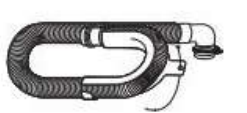
- Drain hose with clamp, U-form, and cable tie.
Parts Needed
Various inlet hose options are available; check your Quick Start Guide for ordering information.
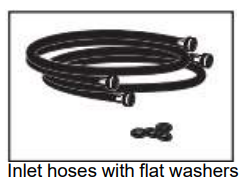
Alternate Parts
- Your installation may require additional parts. To order, please refer to the contact information referenced in your Quick Start Guide.
Overhead sewer
- Standard 20 gallons (76 L) 39″ (990 mm) tall drain tub or utility sink, sump pump, and connectors (available from local plumbing suppliers).
1″ (25 mm) standpipe
- 2″ (51 mm) diameter to 1″ (25 mm) diameter standpipe adapter and connector kit.
Drain hose too short, Lint-clogged drain
- Drain protector and connector kit
Location Requirements
Select a proper location for your washer to improve performance and minimize noise and possible “washer walk.” Install your washer in a basement, laundry room, closet, or recessed area.
You will need
- A water heater set to 120°F (49°C).
- A grounded electrical outlet located within 4 ft (1.2 m) of the power cord on the back of the washer.
- Hot and cold water faucets located within 3 ft (0.9 m) of hot and cold water fill valves on the washer, and water pressure of 20-100 psi (138-690 kPa).
- A level floor with a maximum slope of 1″ (25 mm) under the entire washer. Installing on carpet or surfaces with foam backing is not recommended.
- Floor must support the washer’s total weight (with water and load) of 315 lbs (143 kgs).
Recessed area or closet installation

All 27″ wide washers should have 19″ (482 mm) clearance, while all 29″ wide washers should have 22″ (559 mm) clearance. All dimensions show recommended spacing allowed, except for closet door ventilation openings, which are the minimum required. This washer has been tested for installation with a spacing of 0″ (0 mm) clearance on the sides. Consider allowing more space for ease of installation and servicing, and spacing for companion appliances and clearances for walls, doors, and floor moldings. Add spacing of 1″ (25 mm) on all sides of the washer to reduce noise transfer. Doors must be louvered or equivalent and have at least 24 in2 (155 cm2) bottom and 48 in2 (210 cm2) top open area. *For additional details (or information) specific to your model, refer to your Quick Start Guide.
Drain System
- A drain system can be installed using a floor drain, wall standpipe, floor standpipe, or laundry tub. Select the method you need.
Floor standpipe drain system
- Minimum diameter for a standpipe drain: 2″ (51 mm). Minimum carry-away capacity: 17 gallons (64 L) per minute. Top of standpipe must be at least 39″ (990 mm) high; install no higher than 96″ (2.44 m) from bottom of washer. If you must install higher than 96″ (2.44 m), you will need a sump pump system
Wall standpipe drain system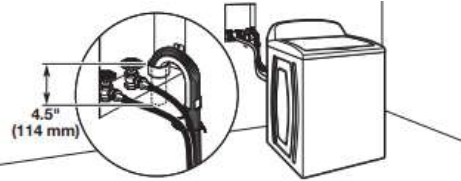
- See requirements in the “Floor standpipe drain system” section.
Laundry tub drain System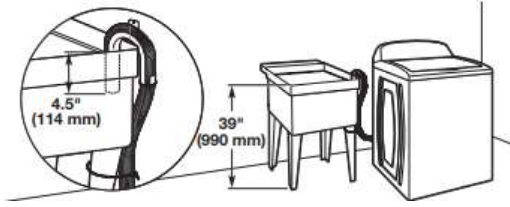
- Minimum capacity: 20 gallons (76 L). The top of the laundry tub must be at least 39″ (990 mm) above the floor; install no higher than 96″ (2.44 m) from the bottom of the washer.
Floor Drain System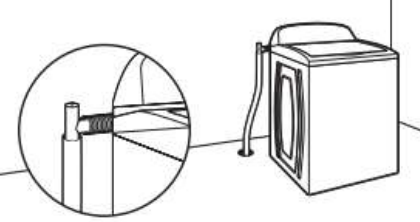
- Floor drain system requires a Siphon Break Kit, 2 Connector Kits, and an Extension Drain Hose that may be purchased separately; refer to the Quick Start Guide for online ordering information. Minimum siphon break height: 28″ (710 mm) from the bottom of the washer (additional hoses may be needed).
INSTALLATION
Unpacking
Before you start
Remove shipping materials. It is necessary to remove all shipping materials for proper operation and to avoid excessive noise from the washer.
- Move Washer
 Move washer to within 4 ft. (1.2 m) of its final location; it must be in a fully upright position.
Move washer to within 4 ft. (1.2 m) of its final location; it must be in a fully upright position. - Remove shipping base
 Removing the shipping base is necessary for proper operation. To avoid damaging the floor, place cardboard supports from the shipping carton on the floor behind the washer. Tip the washer back and place it on cardboard supports. Remove shipping base (some models require the shipping base to be rotated 90° to the right before pulling off). Set the washer upright.
Removing the shipping base is necessary for proper operation. To avoid damaging the floor, place cardboard supports from the shipping carton on the floor behind the washer. Tip the washer back and place it on cardboard supports. Remove shipping base (some models require the shipping base to be rotated 90° to the right before pulling off). Set the washer upright. - Remove packaging material from inside the washer
 Remove tape from the washer lid, open the lid, and remove packaging material from the washer tub. Be sure that all parts have been removed from inside the washer.
Remove tape from the washer lid, open the lid, and remove packaging material from the washer tub. Be sure that all parts have been removed from inside the washer. - Free power cord
 Firmly grasp the power cord plug and pull to free it from the rear panel. Gently place the power cord over the console to allow free access to the back of the washer.
Firmly grasp the power cord plug and pull to free it from the rear panel. Gently place the power cord over the console to allow free access to the back of the washer.
Connect Drain Hose
- Attach the drain hose to the drain port

- If applicable, remove the red plastic plug from the black drain port on the back of the washer. If the clamp is not already in place on the elbow end of the drain hose, slide it over the end as shown. Squeeze the clamp with pliers and slide the black elbow end of the drain hose onto the black drain port and secure with a clamp.
- For a laundry tub or standpipe drain, go to step 6. For a floor drain, remove the pre-installed drain hrom as shown in step 7. You may need additional parts with separate directions. See the “Alternate Parts” section.
- Place the drain hose in the standpipe
 4.5″ (114 mm) of drain hose should be inside the standpipe; do not force excess hose into the standpipe or lay it on the bottom of the laundry tub. Drain hose form must be used. Place the hose into the standpipe (shown in the picture) or over the side of the laundry tub.
4.5″ (114 mm) of drain hose should be inside the standpipe; do not force excess hose into the standpipe or lay it on the bottom of the laundry tub. Drain hose form must be used. Place the hose into the standpipe (shown in the picture) or over the side of the laundry tub. - Remove drain hose from (floor drain installations only)
 For floor drain installations, you will need to remove the drain hose from the end of the hose. You may need additional parts with separate directions. See “Tools and Parts.” It is the responsibility of the installer to install and secure the drain hose into the provided plumbing/drain in a manner that will avoid the drain hose coming out of and leaking from the plumbing/drain.
For floor drain installations, you will need to remove the drain hose from the end of the hose. You may need additional parts with separate directions. See “Tools and Parts.” It is the responsibility of the installer to install and secure the drain hose into the provided plumbing/drain in a manner that will avoid the drain hose coming out of and leaking from the plumbing/drain.
Connect Inlet Hoses
Washer must be connected to water faucets with new inlet hoses with flat washers (not provided). Do not use old hoses. Both hoses must be attached and have water flowing to the inlet valves. If you are only connecting to a cold water faucet, you must use a Y-adapter (not provided).
- Connect inlet hoses to water faucets
 Do not overtighten the hose or use tape or sealants on the valve. Damage to the valves can result. Attach the hose to the hot water faucet. Screw on the coupling by hand until it is seated on the washer. Use adjustable pliers to tighten couplings an additional two-thirds turn. Repeat this step with the second hose for the cold water faucet.
Do not overtighten the hose or use tape or sealants on the valve. Damage to the valves can result. Attach the hose to the hot water faucet. Screw on the coupling by hand until it is seated on the washer. Use adjustable pliers to tighten couplings an additional two-thirds turn. Repeat this step with the second hose for the cold water faucet. - Clear water lines
 Run water for a few seconds through hoses into a laundry tub, drainpipe, or bucket to avoid clogs. Water should run until clear. Make note of which hose is connected to the hot water to help in attaching hoses to the washer correctly.
Run water for a few seconds through hoses into a laundry tub, drainpipe, or bucket to avoid clogs. Water should run until clear. Make note of which hose is connected to the hot water to help in attaching hoses to the washer correctly.
Connect inlet hoses to the washer
- To reduce the risk of hose failure, replace the hoses every 5 years. Record hose installation or replacement dates for future reference.
- Do not overtighten the hose or use tape or sealants on the valve. Damage to the valves can result.
- Periodically inspect and replace hoses if bulges, kinks, cuts, wear, or leaks are found.
- Attach the hot water hose to the red hot water inlet valve. Screw the coupling by hand until it is snug.
- Use pliers to tighten couplings an additional two-thirds turn. Repeat with the cold
water inlet valve. - Check for leaks
 Turn on water faucets to check for leaks. A small amount of water may enter the washer. It will drain later.
Turn on water faucets to check for leaks. A small amount of water may enter the washer. It will drain later. - Secure drain hose
 Secure drain hose to the laundry tub leg, drain standpipe, or inlet hoses for the wall standpipe with a cable tie. It is the responsibility of the installer to install and secure the drain hose into the provided plumbing/drain in a manner that will avoid the drain hose coming out of or leaking from the plumbing/drain.
Secure drain hose to the laundry tub leg, drain standpipe, or inlet hoses for the wall standpipe with a cable tie. It is the responsibility of the installer to install and secure the drain hose into the provided plumbing/drain in a manner that will avoid the drain hose coming out of or leaking from the plumbing/drain.
Level Washer
Level the washer properly to reduce excess noise and vibration.
- Check the levelness of the washer
 Move the washer to its final location. Place a level on the top edges of the washer. Use the side seam as a guide to check the levelness of the sides. Check the levelness of the front using the lid, as shown. Rock the washer back and forth to make sure all four feet make solid contact with the floor. If the washer is level, skip to step 15.
Move the washer to its final location. Place a level on the top edges of the washer. Use the side seam as a guide to check the levelness of the sides. Check the levelness of the front using the lid, as shown. Rock the washer back and forth to make sure all four feet make solid contact with the floor. If the washer is level, skip to step 15.
- Adjust leveling feet
If the washer is not level: Use adjustable pliers to turn the plastic leveling foot counterclockwise to lower the washer or clockwise to raise the washer. Recheck the levelness of the washer and repeat as needed.- HELPFUL TIPS
- You may need to adjust two different feet to level your unit. Ensure each foot remains secured to the washer’s base.
- You may want to prop up the front of the Whirlpool W11354658B Top Load Washer washer about 4″ (102 mm) with a wood block or similar object that Whirlpool W11354658B Top Load Washer will support the weight of the washer.
- Plug into a grounded 3-prong outlet.

Complete Installation Checklist
- Check electrical requirements. Be sure you have the correct electrical supply and the recommended grounding method.
- Check that you have all of your tools.
- Check that water faucets are on.
- Check for leaks around faucets and inlet hoses.
- Remove protective film from the console and any tape remaining on the washer.
- Check that the washer is plugged into a grounded 3-prong outlet.
- Dispose of/recycle all packaging materials.
- Read the “Washer Maintenance and Care” section.
- To test and clean your washer, measure 1/2 of the normal recommended amount of powdered or liquid HE detergent and pour it into the washer basket or detergent dispenser (on some models). Close lid. Select any cycle. Start the washer and allow it to complete a full cycle.
Choosing the Right Detergent
Use only high-efficiency detergents. The package will be marked “HE” or “High Efficiency.” Low-water washing creates excessive sudsing with a non-HE detergent. Using a non-HE detergent will likely result in longer cycle times and reduced rinsing performance. Whirlpool W11354658B Top Load Washer It may also result in component malfunction and, over time, buildup of mold or mildew. HE detergents should be low-sudsing and quick-dispersing to produce the right amount of suds for the best performance.
They should hold soil in suspension so it is not redeposited onto clean clothes. Not all detergents labeled as High Efficiency are identical in formulation and their ability to reduce suds. For example, natural, organic, or homemade HE detergents may generate a high level of suds. Always follow the detergent manufacturer’s instructions to determine the amount of detergent to use. Do not go over the Max Line on the dispenser. See Quick Start Guide for more information.
Maintainance & Care
Water Inlet Hoses
Replace inlet hoses after 5 years of use to reduce the risk of hose failure. Periodically inspect and replace inlet hoses if bulges, kinks, cuts, wear, or leaks are found. When replacing your inlet hoses:
- Mark the date of replacement on the label with a permanent marker.
- Check that the old washers are not stuck on the washer inlet valves.
Washer Care
- Always use High Efficiency (HE) detergents and follow the HE detergent manufacturer’s instructions regarding the amount of HE detergent to use. Never Whirlpool W11354658B Top Load Washer use more than the recommended amount because that may increase the rate at which detergent and soil residue accumulate inside your washer, which in turn may result in an undesirable odor.
- Use warm and hot wash water settings sometimes (not exclusively cold water washes), because they do a better job of controlling the rate at which soils and detergent accumulate.
- Always leave the washer lid open between uses to help dry out the washer and prevent the buildup of odor-causing residue.
Cleaning the inside of the washer
To keep your washer odor-free, follow the usage instructions Whirlpool W11354658B Top Load Washer provided above and use this recommended monthly cleaning procedure.
Recommended cycle for cleaning the Washer
Some models have a “Clean Washer” cycle that uses higher water volumes in combination with affresh® Washer Cleaner or liquid chlorine bleach to clean the inside of the washer. If your model does not have a “Clean Washer” cycle, refer to the online Cycle Guide for the optimal cycle for cleaning the inside of the washer. Use this cycle with affresh® Washer Cleaner or liquid chlorine bleach as described below.
Description of Clean Washer with affresh® cycle operation
- This cycle will fill to a washer level high than in normal wash cycles to provide rinsing than in normal wash cycles to provide rinsing at a level above the water line for normal wash.
- During this cycle, there will be some agitation and spinning to increase the removal of soils.
After this cycle is complete, leave the lid open to allow for better ventilation and drying of the washer interior.
Begin procedure
- Affresh washer cleaner cycle procedure (recommended for best performance)
- Open the washer lid and remove any clothing or items.
- Place an affresh® Washer Cleaner tablet in the bottom of the washer basket.
- Do not place an affresh® Washer Cleaner tablet in the detergent dispenser.
- Do not add any detergent or other chemicals to the washer when following this procedure.
- Close the washer lid.
- Select the cycle recommended for cleaning Whirlpool W11354658B Top Load Washer the inside of the washer.
- Press the START button to start the cycle.
- Chlorine bleach procedure (alternative)
- Open the washer lid and remove any clothing or items.
- Add 1 cup (236 mL) of liquid chlorine bleach to the bleach compartment.
- Close the washer lid.
- Do not add any detergent or other chemicals to the washer when following this procedure.
- Select the cycle recommended for cleaning the inside of the washer.
- Press the START button to start the cycle.
Cleaning the dispensers
For non-removable dispensers
- To remove residue from the dispensers, wipe them with an affresh® Machine Cleaning Wipe or a damp cloth and towel dry. Do not attempt to remove the dispensers or trim for cleaning. The dispensers and trim are not removable.
For removable dispensers
- If your model has a dispenser drawer, press tab(s) to remove the drawer and clean it with an affresh® Machine Cleaning Wipe or a damp cloth and towel dry before or after you run the Clean Washer cycle. Use an all-purpose surface cleaner, if needed.
Cleaning the outside of the washer
- To avoid damaging the washer’s finish, do not use abrasive products. Use an affresh® Machine Cleaning Wipe, a soft, damp cloth, or sponge to wipe away any spills. Use an affresh® Machine Cleaning Wipe or only mild soaps or cleaners when cleaning external washer surfaces.
Non-Use and Vacation Care
Operate your washer only when you are home. If moving Whirlpool W11354658B Top Load Washer or not using your washer for a period of time, follow these steps:
- Unplug or disconnect power to the water heater.
- Turn off the water supply to the washer to avoid flooding due to a water pressure surge.
Winter Storage Care
To avoid damage, install and store the washer where it will not freeze. Because some water may stay in hoses, freezing can damage the washer. If storing or moving during freezing weather, winterize your washer.
To winterize the washer
- Shut off both water faucets; disconnect and drain water inlet hoses.
- Put 1 L (1 quart) of R.V.-type antifreeze in the basket and run the washer on Rinse & Spin cycle for about 30 seconds to mix antifreeze and remaining water.
- Unplug the washer or disconnect the power.
Transporting Your Washer
- Shut off both water faucets. Disconnect and drain water inlet hoses.
- Disconnect the drain hose from the drain system and drain any remaining water into a pan or bucket. Disconnect the drain hose from the back of the washer.
- Unplug the power cord.
- Place the inlet hoses and the drain hose inside the washer basket.
- Drape the power cord over the edge and into the washer basket.
Reinstalling
To reinstall the washer after nonuse, vacation, winter storage, or moving:
- Refer to Installation Instructions to locate, level, and connect the washer.
- Before using again, run the washer through the following recommended procedure:
To use the washer again
- Flush water pipes and hoses.
- Reconnect water inlet hoses.
- Turn on both water faucets.
- Plug into a grounded 3-prong outlet or Whirlpool W11354658B Top Load Washer reconnect power.
Customer Service
- Website: https://www.whirlpool.com/
- Ph: 1-800-253-1301
FAQs
What type of washer is the Whirlpool W11354658B?
The W11354658B is a high-efficiency (HE), fully automatic top-load washer, designed to deliver optimal cleaning performance while conserving water and energy.
Does this washer require both hot and cold water connections?
Yes, it requires both hot and cold water connections to properly operate temperature-based wash cycles.
How do I level the washer?
Adjust the washer’s front leveling feet using a wrench. A level washer ensures reduced noise and vibration during spin cycles.
Can I adjust soil level, spin speed, or water temperature?
Yes. Use the cycle modifiers on the control panel to select your desired soil level, spin speed, and wash temperature based on your fabric and load type.
Can I pause the cycle to add more clothes?
Yes. Press Start/Pause to temporarily stop the cycle. Wait for the lid lock light to turn off, then open the lid to add items. Close the lid and press Start to resume.
How much laundry can I load at once?
Load the drum loosely up to the top row of holes. Avoid overpacking, as this affects cleaning performance and balance during the spin cycle.
What type of detergent should I use?
Only use High-Efficiency (HE) detergent. Using regular detergent may cause excess suds, poor rinsing, and potential damage to the washer.
How do I clean the lint or drain filter?
This model may include a self-cleaning filter, but check your manual. If accessible, remove and rinse the filter monthly to prevent buildup.


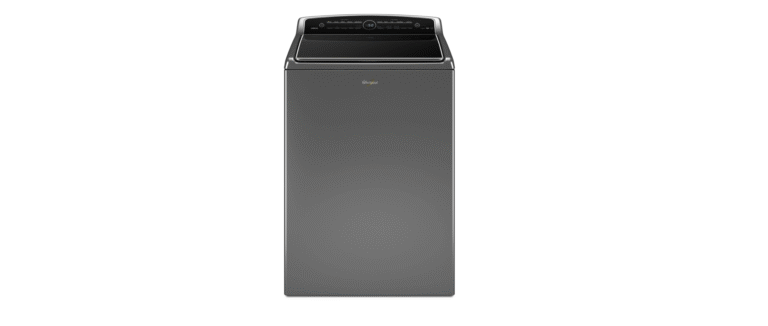

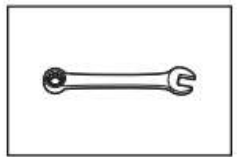
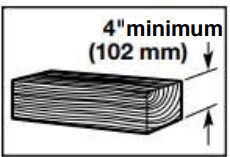
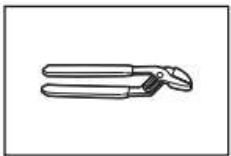
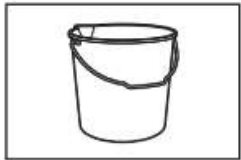

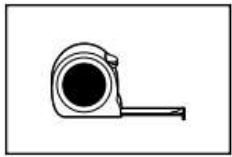
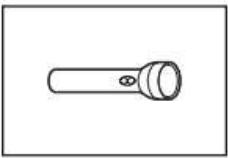
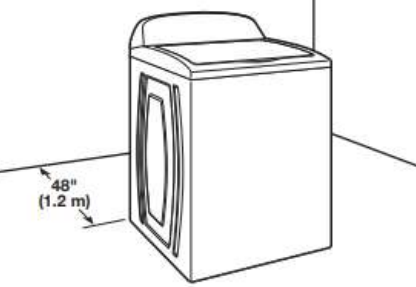 Move washer to within 4 ft. (1.2 m) of its final location; it must be in a fully upright position.
Move washer to within 4 ft. (1.2 m) of its final location; it must be in a fully upright position.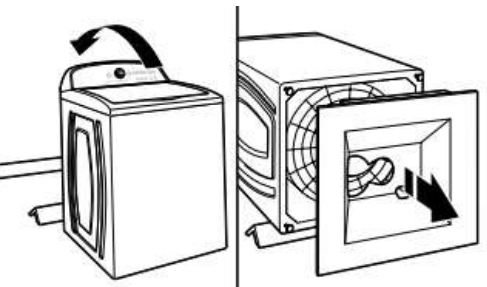 Removing the shipping base is necessary for proper operation. To avoid damaging the floor, place cardboard supports from the shipping carton on the floor behind the washer. Tip the washer back and place it on cardboard supports. Remove shipping base (some models require the shipping base to be rotated 90° to the right before pulling off). Set the washer upright.
Removing the shipping base is necessary for proper operation. To avoid damaging the floor, place cardboard supports from the shipping carton on the floor behind the washer. Tip the washer back and place it on cardboard supports. Remove shipping base (some models require the shipping base to be rotated 90° to the right before pulling off). Set the washer upright.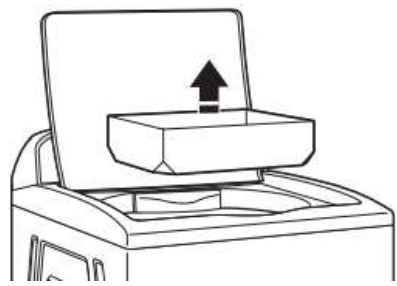 Remove tape from the washer lid, open the lid, and remove packaging material from the washer tub. Be sure that all parts have been removed from inside the washer.
Remove tape from the washer lid, open the lid, and remove packaging material from the washer tub. Be sure that all parts have been removed from inside the washer.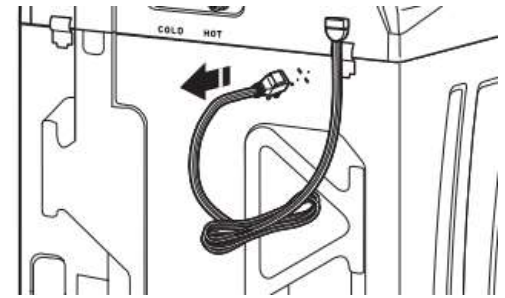 Firmly grasp the power cord plug and pull to free it from the rear panel. Gently place the power cord over the console to allow free access to the back of the washer.
Firmly grasp the power cord plug and pull to free it from the rear panel. Gently place the power cord over the console to allow free access to the back of the washer.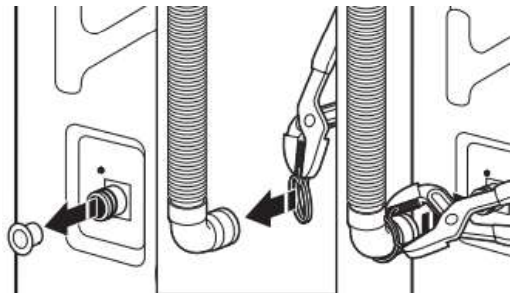
 4.5″ (114 mm) of drain hose should be inside the standpipe; do not force excess hose into the standpipe or lay it on the bottom of the laundry tub. Drain hose form must be used. Place the hose into the standpipe (shown in the picture) or over the side of the laundry tub.
4.5″ (114 mm) of drain hose should be inside the standpipe; do not force excess hose into the standpipe or lay it on the bottom of the laundry tub. Drain hose form must be used. Place the hose into the standpipe (shown in the picture) or over the side of the laundry tub.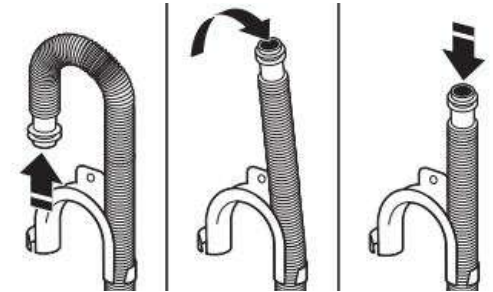 For floor drain installations, you will need to remove the drain hose from the end of the hose. You may need additional parts with separate directions. See “Tools and Parts.” It is the responsibility of the installer to install and secure the drain hose into the provided plumbing/drain in a manner that will avoid the drain hose coming out of and leaking from the plumbing/drain.
For floor drain installations, you will need to remove the drain hose from the end of the hose. You may need additional parts with separate directions. See “Tools and Parts.” It is the responsibility of the installer to install and secure the drain hose into the provided plumbing/drain in a manner that will avoid the drain hose coming out of and leaking from the plumbing/drain.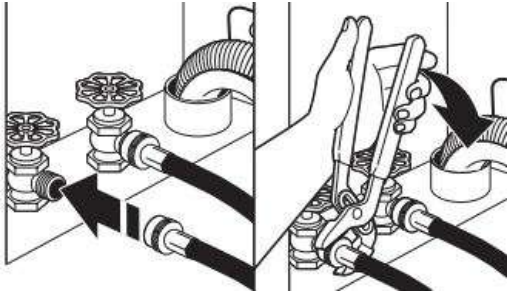 Do not overtighten the hose or use tape or sealants on the valve. Damage to the valves can result. Attach the hose to the hot water faucet. Screw on the coupling by hand until it is seated on the washer. Use adjustable pliers to tighten couplings an additional two-thirds turn. Repeat this step with the second hose for the cold water faucet.
Do not overtighten the hose or use tape or sealants on the valve. Damage to the valves can result. Attach the hose to the hot water faucet. Screw on the coupling by hand until it is seated on the washer. Use adjustable pliers to tighten couplings an additional two-thirds turn. Repeat this step with the second hose for the cold water faucet.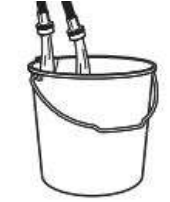 Run water for a few seconds through hoses into a laundry tub, drainpipe, or bucket to avoid clogs. Water should run until clear. Make note of which hose is connected to the hot water to help in attaching hoses to the washer correctly.
Run water for a few seconds through hoses into a laundry tub, drainpipe, or bucket to avoid clogs. Water should run until clear. Make note of which hose is connected to the hot water to help in attaching hoses to the washer correctly.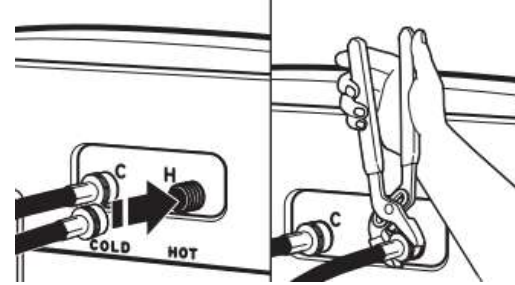
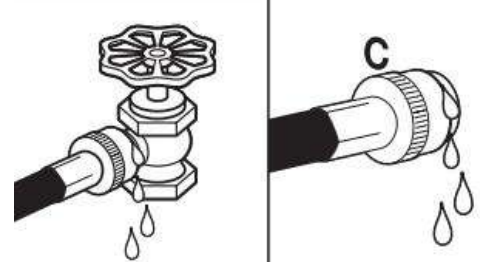 Turn on water faucets to check for leaks. A small amount of water may enter the washer. It will drain later.
Turn on water faucets to check for leaks. A small amount of water may enter the washer. It will drain later.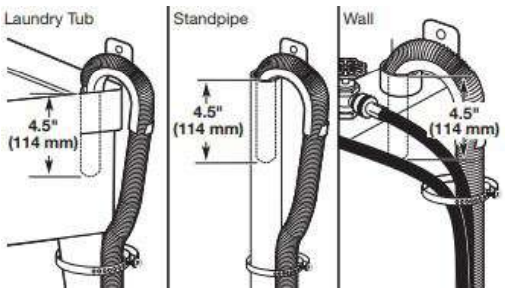 Secure drain hose to the laundry tub leg, drain standpipe, or inlet hoses for the wall standpipe with a cable tie. It is the responsibility of the installer to install and secure the drain hose into the provided plumbing/drain in a manner that will avoid the drain hose coming out of or leaking from the plumbing/drain.
Secure drain hose to the laundry tub leg, drain standpipe, or inlet hoses for the wall standpipe with a cable tie. It is the responsibility of the installer to install and secure the drain hose into the provided plumbing/drain in a manner that will avoid the drain hose coming out of or leaking from the plumbing/drain.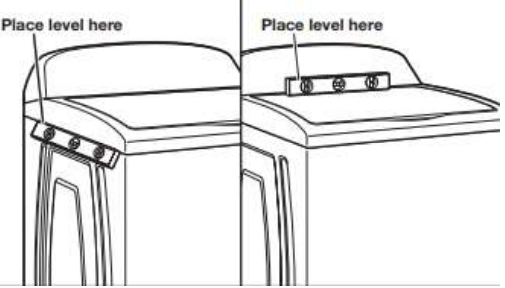 Move the washer to its final location. Place a level on the top edges of the washer. Use the side seam as a guide to check the levelness of the sides. Check the levelness of the front using the lid, as shown. Rock the washer back and forth to make sure all four feet make solid contact with the floor. If the washer is level, skip to step 15.
Move the washer to its final location. Place a level on the top edges of the washer. Use the side seam as a guide to check the levelness of the sides. Check the levelness of the front using the lid, as shown. Rock the washer back and forth to make sure all four feet make solid contact with the floor. If the washer is level, skip to step 15.